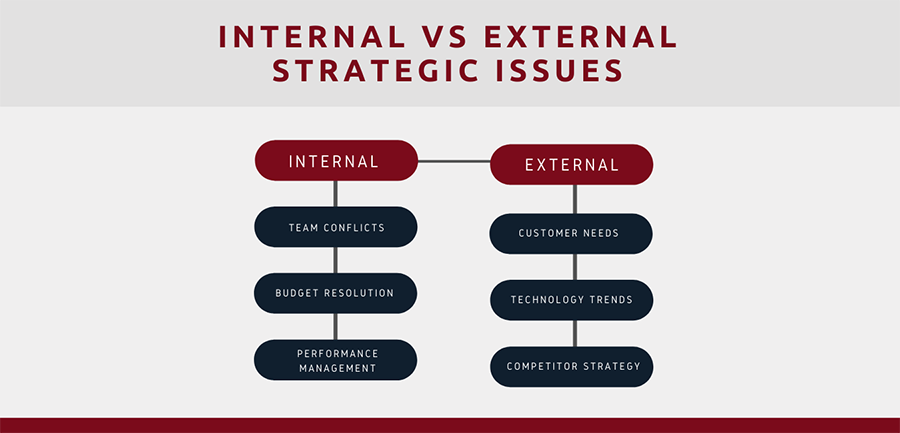Are you confident about your business strategy? Perhaps. Are you confident about the leaders entrusted with that strategy? TSI investigates why harmony between business strategy and leadership is a must, and how developing a leadership strategy can accomplish that.
Misalignment between goals and execution costs a lot to organizations. Is poor planning corroding your results and leading to missed numbers with poor customer experience, lost revenue, and low employee morale?
As a leader, you wouldn’t want your business unit to look like it.

Among many explanations for the failure of implementation and execution, one clear reason is the leadership itself. The role of a leader is critical in implementing strategy. Without good leadership, a good strategy cannot happen.
In most organizations, corporate strategy is formed at the top, and then CEOs, COOs, and other operational directors form and implement business strategy for their constituent business units. Many business strategists and leaders aren’t prepared for the responsibility of strategic tasks that come with it. And what more, every leader interprets the strategy in her own way.
Preparing leaders for people and process leadership can reduce business strategy failures and help revenues thrive.
Whether you are a business leader, an entrepreneur, or an organization (startup or enterprise), you can benefit from crafting a leadership strategy that will inform the right execution of your business strategy. Do you have a leadership strategy?
Leadership strategy is a map for leaders – CEOs, COOs, Operational Directors, Managers, and Team Leads – that align leaders with the business strategy (company vision, goals, and missions) – and help them develop a ground zero plan on how to accomplish results.
It defines the following key aspects:
- How many leaders does a business need?
- What type of leaders does it need?
- Where should they be positioned?
- What skills should they possess?
- What should be their behavior with individuals and within teams?
Finding answers to these aspects of leadership can help a leader, a business strategist, and even an organization to understand the fault lines leading to disharmony between their business strategy, and strategy execution.
While we have discussed at length on how to form a business strategy in our previous articles, the obstructions in execution have not been deliberated upon much. In this article, we understand what causes unsuccessful leadership on the ground, and how it can be course corrected.
Most leaders have strong operational skills and are versed in the art and science of maintaining the status quo. But new-age businesses are marked by continuously changing strategies, change management, software hit-and-trials, and more such disruptions. Business leaders need more than just operational skills in making a business strategy a success.
Before we go on to the solutions of how leaders can better buck up for strategy implementation challenges, let’s have a look at the three root causes of why leaders fail to translate strategies on the ground.
First and foremost reason why leaders lose sight of business strategy is because they often become overly focused on internal matters, instead of external, with former including budget reconciliation, team conflicts, and performance management, and the latter comprising competitor strategy, technology trends, and consumer demands.

According to a study on strategy implementation by Bridge Business Consultancy, most leaders spend one day a month reviewing their strategy, and as little as an hour a month discussing it.
No wonder execution on the ground lacks a focus on external issues!
Overindulgence with internal issues leads to overlooking the most fundamental competitive and financial context of your business units and strategy in question.
This limitation is essentially about, “doing too much in too little time or with too little resources,” a scenario most small-medium business leaders struggle with, albeit it is not so uncommon among enterprise leaders too.
Do you take up more priority tasks than you can handle? Are your teams struggling with more than 3 to 5 most important projects? The more “high-priority” tasks you take up at a time, the lesser will become the success rate for those tasks.
Many leaders, especially new business strategists, underestimate the importance of making trade-offs and choices between tasks or projects. Saying a “no” is a skill.
Trade-offs and outlining your priorities are critical for success. If you take up a lot in a lot less, you are bound to doom. For every idea you say a “yes” to, it has to be followed by saying a “no” to many others for the sake of the success of the first.
The mistake business leaders make is overestimating their capabilities and setting unrealizable targets. Stretch goals and challenge assignments may give you psychological safety that you and your resources are at work but overdoing almost always lead to burnout and strategy execution failure.
Many leaders are guilty of this. It’s about not realizing the importance of “organizational design” in business strategy and instead of putting too much brains into the hierarchical aspects. 0Organizational design represents the overall workflow and focus of a company. Some strategists even call it “a living embodiment” of a business.
Organizational design is “aligning the organization” with the “objectives of business strategy” to improve efficiency. It includes identifying the aspects of your workflow that are not working for you, and the procedures/structures/systems that need rework basis on your current business reality and goals.
Deloitte says, “Organizational design allows companies to accelerate complex business environments by directly aligning the organization with the strategy and business model. With success, the performance of people within a business unit is enhanced as well.”
Instead of focusing on it during strategy execution, what many leaders do is pulling organizational chart, shifting people across roles, and the likes. An overemphasis on the organizational chart and shifting pieces of hierarchy in the hopes that it alone will lift the performance can be counterproductive. It can be luring, but many researches and experiences have revealed its effectiveness to be otherwise.
Great business leaders are architects of organizations. They don’t just look at the organizational chart, but also (rather primarily) the processes, governance structure, culture, technologies, etc.
Are you prepared to overcome these myopias in your leadership?
The trick is to prepare yourself for leadership on the ground, which entails developing a leadership strategy. As you do that, you would see your failure rates decline and your business strategy thrive.
A leadership strategy will help you set certain boundaries for yourself, and your people, and broaden your outlook on a problem. For instance, taking you from being too focused internally to make you more aware of the overall industry and market challenges.
As a part of their leadership strategy, instead of showing growth targets, great business leaders describe what’s their market identity, who do they serve, why their consumers choose them, and what makes them better than the competitors.
To develop a leadership strategy, imagine what a future perfect stage will look like for your business by asking that if everything in business was running at peak efficiency,
What would be the company culture like?
What would be leaders’ behavior?
What would be the shared beliefs of teams and people in the organization?
Once done, form your leadership strategy and set your boundaries around the practices that your “perfect future” vision holds.
The default assumption that the business strategy framed on the top will be led perfectly on the ground is an anomaly. It’s not so obvious. Business strategy goes hand-in-gloves with leadership strategy.
Leaders must prepare for the real ground zero needs of their role. It requires a careful crafting of a leadership strategy. Don’t just match your business strategy requirements with the leadership competence you have. Build leadership capabilities and see your business adapt and succeed.
Aspirants launching a career in business strategy, new leaders, and even seasoned professionals can benefit an effective leadership strategy. Do you have yours in place?
Take a quantum leap in your business strategy career with professional certifications recognized by the industry to help you prepare for efficient business strategy formulation and execution.

CredBadge™ is a proprietary, secure, digital badging platform that provides for seamless authentication and verification of credentials across digital media worldwide.
CredBadge™ powered credentials ensure that professionals can showcase and verify their qualifications and credentials across all digital platforms, and at any time, across the planet.

Keep yourself informed on the latest updates and information about business strategy by subscribing to our newsletter.